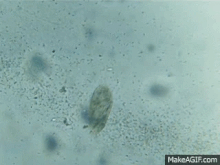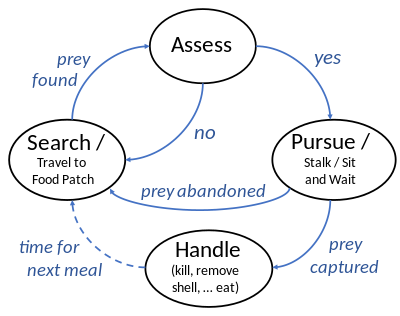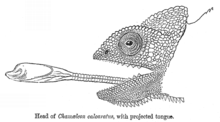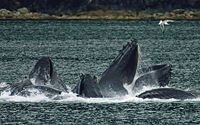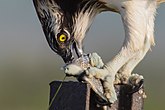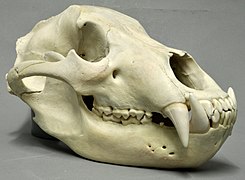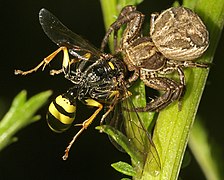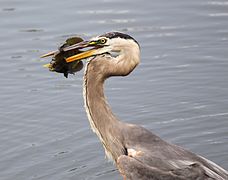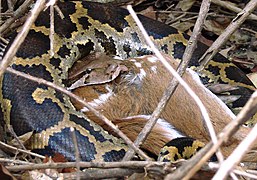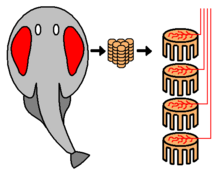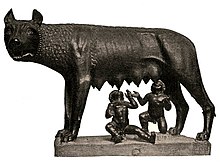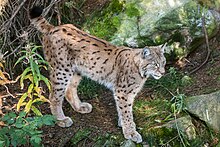Solitary predator: a polar bear feeds on a bearded seal it has killed.
Predation is a biological interaction where one organism, the predator, kills and eats another organism, its prey. It is one of a family of common feeding behaviours that includes parasitism and micropredation (which usually do not kill the host) and parasitoidism (which always does, eventually). It is distinct from scavenging on dead prey, though many predators also scavenge; it overlaps with herbivory, as seed predators and destructive frugivores are predators.
Predators may actively search for or pursue prey or wait for it,
often concealed. When prey is detected, the predator assesses whether to
attack it. This may involve ambush or pursuit predation,
sometimes after stalking the prey. If the attack is successful, the
predator kills the prey, removes any inedible parts like the shell or
spines, and eats it.
Predators are adapted and often highly specialized for hunting, with acute senses such as vision, hearing, or smell. Many predatory animals, both vertebrate and invertebrate, have sharp claws or jaws to grip, kill, and cut up their prey. Other adaptations include stealth and aggressive mimicry that improve hunting efficiency.
Predation has a powerful selective effect on prey, and the prey develop antipredator adaptations such as warning coloration, alarm calls and other signals, camouflage, mimicry of well-defended species, and defensive spines and chemicals. Sometimes predator and prey find themselves in an evolutionary arms race, a cycle of adaptations and counter-adaptations. Predation has been a major driver of evolution since at least the Cambrian period.
Definition
Spider wasps paralyse and eventually kill their hosts, but are considered parasitoids, not predators.
At the most basic level, predators kill and eat other organisms.
However, the concept of predation is broad, defined differently in
different contexts, and includes a wide variety of feeding methods; and
some relationships that result in the prey's death are not generally
called predation. A parasitoid, such as an ichneumon wasp,
lays its eggs in or on its host; the eggs hatch into larvae, which eat
the host, and it inevitably dies. Zoologists generally call this a form
of parasitism,
though conventionally parasites are thought not to kill their hosts. A
predator can be defined to differ from a parasitoid in that it has many
prey, captured over its lifetime, where a parasitoid's larva has just
one, or at least has its food supply provisioned for it on just one
occasion.
Relation of predation to other feeding strategies
There are other difficult and borderline cases. Micropredators are small animals that, like predators, feed entirely on other organisms; they include fleas and mosquitoes that consume blood from living animals, and aphids
that consume sap from living plants. However, since they typically do
not kill their hosts, they are now often thought of as parasites. Animals that graze on phytoplankton
or mats of microbes are predators, as they consume and kill their food
organisms; but herbivores that browse leaves are not, as their food
plants usually survive the assault. When animals eat seeds (seed predation or granivory) or eggs (egg predation), they are consuming entire living organisms, which by definition makes them predators.
Scavengers, organisms that only eat organisms found already dead, are not predators, but many predators such as the jackal and the hyena scavenge when the opportunity arises. Among invertebrates, social wasps (yellowjackets) are both hunters and scavengers of other insects.
Taxonomic range
Seed predation: mouse eating seeds
While examples of predators among mammals and birds are well known, predators can be found in a broad range of taxa including arthropods. They are common among insects, including mantids, dragonflies, lacewings and scorpionflies. In some species such as the alderfly,
only the larvae are predatory (the adults do not eat). Spiders are
predatory, as well as other terrestrial invertebrates such as scorpions; centipedes; some mites, snails and slugs; nematodes; and planarian worms. In marine environments, most cnidarians (e.g., jellyfish, hydroids), ctenophora (comb jellies), echinoderms (e.g., sea stars, sea urchins, sand dollars, and sea cucumbers) and flatworms are predatory. Among crustaceans, lobsters, crabs, shrimps and barnacles are predators, and in turn crustaceans are preyed on by nearly all cephalopods (including octopuses, squid and cuttlefish).
Arthropods have also been found to be a common predator to a wide range
of vertebrates such as amphibians, reptiles, birds, fish, and mammals.
Seed predation is restricted to mammals, birds, and insects and is found in almost all terrestrial ecosystems. Egg predation includes both specialist egg predators such as some colubrid snakes and generalists such as foxes and badgers that opportunistically take eggs when they find them.
Some plants, like the pitcher plant, the Venus fly trap and the sundew, are carnivorous and consume insects. Some carnivorous fungi catch nematodes using either active traps in the form of constricting rings, or passive traps with adhesive structures.
Many species of protozoa (eukaryotes) and bacteria (prokaryotes) prey on other microorganisms; the feeding mode is evidently ancient, and evolved many times in both groups. Among freshwater and marine zooplankton, whether single-celled or multi-cellular, predatory grazing on phytoplankton and smaller zooplankton is common, and found in many species of nanoflagellates, dinoflagellates, ciliates, rotifers, a diverse range of meroplankton animal larvae, and two groups of crustaceans, namely copepods and cladocerans.
Foraging
A basic foraging cycle for a predator, with some variations indicated
To feed, a predator must search for, pursue and kill its prey. These actions form a foraging cycle.
The predator must decide where to look for prey based on its
geographical distribution; and once it has located prey, it must assess
whether to pursue it or to wait for a better choice. If it chooses
pursuit, its physical capabilities determine the mode of pursuit (e.g.,
ambush or chase). Having captured the prey, it may also need to expend energy handling it (e.g., killing it, removing any shell or spines, and ingesting it).
Search
Predators have a choice of search modes ranging from sit-and-wait to active or widely foraging. The sit-and-wait method is most suitable if the prey are dense and mobile, and the predator has low energy requirements. Wide foraging expends more energy, and is used when prey is sedentary or sparsely distributed. There is a continuum of search modes with intervals between periods of movement ranging from seconds to months. Sharks, sunfish, Insectivorous birds and shrews are almost always moving while web-building spiders, aquatic invertebrates, praying mantises and kestrels rarely move. In between, plovers and other shorebirds, freshwater fish including crappies, and the larvae of coccinellid beetles (ladybirds), alternate between actively searching and scanning the environment.
The black-browed albatross regularly flies hundreds of kilometres across the nearly empty ocean to find patches of food.
Prey distributions are often clumped, and predators respond by looking for patches where prey is dense and then searching within patches.
Where food is found in patches, such as rare shoals of fish in a nearly
empty ocean, the search stage requires the predator to travel for a
substantial time, and to expend a significant amount of energy, to
locate each food patch. For example, the black-browed albatross
regularly makes foraging flights to a range of around 700 kilometres
(430 miles), up to a maximum foraging range of 3,000 kilometres (1,860
miles) for breeding birds gathering food for their young. With static prey, some predators can learn suitable patch locations and return to them at intervals to feed. The optimal foraging strategy for search has been modelled using the marginal value theorem.
Search patterns often appear random. One such is the Lévy walk, that tends to involve clusters of short steps with occasional long steps. It is a good fit to the behaviour of a wide variety of organisms including bacteria, honeybees, sharks and human hunter-gatherers.
Assessment
Seven-spot ladybirds select plants of good quality for their aphid prey.
Having found prey, a predator must decide whether to pursue it or
keep searching. The decision depends on the costs and benefits involved.
A bird foraging for insects spends a lot of time searching but
capturing and eating them is quick and easy, so the efficient strategy
for the bird is to eat every palatable insect it finds. By contrast, a
predator such as a lion or falcon finds its prey easily but capturing it
requires a lot of effort. In that case, the predator is more selective.
One of the factors to consider is size. Prey that is too small
may not be worth the trouble for the amount of energy it provides. Too
large, and it may be too difficult to capture. For example, a mantid
captures prey with its forelegs and they are optimized for grabbing prey
of a certain size. Mantids are reluctant to attack prey that is far
from that size. There is a positive correlation between the size of a
predator and its prey.
A predator may also assess a patch and decide whether to spend time searching for prey in it. This may involve some knowledge of the preferences of the prey; for example, ladybirds can choose a patch of vegetation suitable for their aphid prey.
Capture
To capture prey, predators have a spectrum of pursuit modes that range from overt chase (pursuit predation) to a sudden strike on nearby prey (ambush predation). Another strategy in between ambush and pursuit is ballistic interception, where a predator observes and predicts a prey's motion and then launches its attack accordingly.
Ambush
A trapdoor spider waiting in its burrow to ambush its prey
Ambush or sit-and-wait predators are carnivorous animals that capture
prey by stealth or surprise. In animals, ambush predation is
characterized by the predator's scanning the environment from a
concealed position until a prey is spotted, and then rapidly executing a
fixed surprise attack. Vertebrate ambush predators include frogs, fish such as the angel shark, the northern pike and the eastern frogfish. Among the many invertebrate ambush predators are trapdoor spiders on land and mantis shrimps in the sea.
Ambush predators often construct a burrow in which to hide, improving
concealment at the cost of reducing their field of vision. Some ambush
predators also use lures to attract prey within striking range. The capturing movement has to be rapid to trap the prey, given that the attack is not modifiable once launched.
Ballistic interception
The chameleon attacks prey by shooting out its tongue.
Ballistic interception is the strategy where a predator observes the
movement of a prey, predicts its motion, works out an interception path,
and then attacks the prey on that path. This differs from ambush
predation in that the predator adjusts its attack according to how the
prey is moving.
Ballistic interception involves a brief period for planning, giving
the prey an opportunity to escape. Some frogs wait until snakes have
begun their strike before jumping, reducing the time available to the
snake to recalibrate its attack, and maximising the angular adjustment
that the snake would need to make to intercept the frog in real time. Ballistic predators include insects such as dragonflies, and vertebrates such as archerfish (attacking with a jet of water), chameleons (attacking with their tongues), and some colubrid snakes.
Pursuit
Humpback whales are lunge feeders, filtering thousands of krill from seawater and swallowing them alive.
In pursuit predation, predators chase fleeing prey. If the prey flees
in a straight line, capture depends only on the predator's being faster
than the prey.
If the prey manoeuvres by turning as it flees, the predator must react
in real time to calculate and follow a new intercept path, such as by parallel navigation, as it closes on the prey. Many pursuit predators use camouflage to approach the prey as close as possible unobserved (stalking) before starting the pursuit.
Pursuit predators include terrestrial mammals such as lions, cheetahs,
and wolves; marine predators such as dolphins and many predatory fishes,
such as tuna; predatory birds (raptors) such as falcons; and insects such as dragonflies.
An extreme form of pursuit is endurance or persistence hunting,
in which the predator tires out the prey by following it over a long
distance, sometimes for hours at a time. The method is used by human hunter-gatherers and in canids such as African wild dogs
and domestic hounds. The African wild dog is an extreme persistence
predator, tiring out individual prey by following them for many miles at
relatively low speed, compared for example to the cheetah's brief high-speed pursuit.
A specialised form of pursuit predation is the lunge feeding of baleen whales. These very large marine predators feed on plankton, especially krill,
diving and actively swimming into concentrations of plankton, and then
taking a huge gulp of water and filtering it through their feathery baleen plates.
Pursuit predators may be social, like the lion and wolf that hunt in groups, or solitary, like the cheetah.
Handling
Catfish has sharp dorsal and pectoral spines which it holds erect to discourage predators such as herons which swallow prey whole.
Once the predator has captured the prey, it has to handle it: very
carefully if the prey is dangerous to eat, such as if it possesses sharp
or poisonous spines, as in many prey fish. Some catfish such as the Ictaluridae have spines on the back (dorsal) and belly (pectoral)
which lock in the erect position; as the catfish thrashes about when
captured, these could pierce the predator's mouth, possibly fatally.
Some fish-eating birds like the osprey avoid the danger of spines by tearing up their prey before eating it.
Solitary versus social predation
In social predation, a group of predators cooperates to kill prey.
This makes it possible to kill creatures larger than those they could
overpower singly; for example, hyenas, and wolves collaborate to catch and kill herbivores as large as buffalo, and lions even hunt elephants.
It can also make prey more readily available through strategies like
flushing of prey and herding it into a smaller area. For example, when
mixed flocks of birds forage, the birds in front flush out insects that
are caught by the birds behind. Spinner dolphins form a circle around a school of fish and move inwards, concentrating the fish by a factor of 200. By hunting socially chimpanzees can catch colobus monkeys that would readily escape an individual hunter, while cooperating Harris hawks can trap rabbits.
Predators of different species sometimes cooperate to catch prey. In coral reefs, when fish such as the grouper and coral trout spot prey that is inaccessible to them, they signal to giant moray eels, Napoleon wrasses or octopuses. These predators are able to access small crevices and flush out the prey. Killer whales have been known to help whalers hunt baleen whales.
Social hunting allows predators to tackle a wider range of prey,
but at the risk of competition for the captured food. Solitary predators
have more chance of eating what they catch, at the price of increased
expenditure of energy to catch it, and increased risk that the prey will
escape. Ambush predators are often solitary to reduce the risk of becoming prey themselves. Of 245 terrestrial carnivores, 177 are solitary; and 35 of the 37 wild cats are solitary, including the cougar and cheetah. However, the solitary cougar does allow other cougars to share in a kill, and the coyote can be either solitary or social. Other solitary predators include the northern pike, wolf spiders and all the thousands of species of solitary wasps among arthropods, and many microorganisms and zooplankton.
Specialization
Physical adaptations
Under the pressure of natural selection, predators have evolved a variety of physical adaptations
for detecting, catching, killing, and digesting prey. These include
speed, agility, stealth, sharp senses, claws, teeth, filters, and
suitable digestive systems.
For detecting prey, predators have well-developed vision, smell, or hearing. Predators as diverse as owls and jumping spiders have forward-facing eyes, providing accurate binocular vision
over a relatively narrow field of view, whereas prey animals often have
less acute all-round vision. Animals such as foxes can smell their prey
even when it is concealed under 2 feet (60 cm) of snow or earth. Many
predators have acute hearing, and some such as echolocating bats hunt exclusively by active or passive use of sound.
Predators including big cats, birds of prey, and ants share powerful jaws, sharp teeth, or claws which they use to seize and kill their prey. Some predators such as snakes and fish-eating birds like herons and cormorants
swallow their prey whole; some snakes can unhinge their jaws to allow
them to swallow large prey, while fish-eating birds have long spear-like
beaks that they use to stab and grip fast-moving and slippery prey. Fish and other predators have developed the ability to crush or open the armoured shells of molluscs.
Many predators are powerfully built and can catch and kill
animals larger than themselves; this applies as much to small predators
such as ants and shrews as to big and visibly muscular carnivores like the cougar and lion.
- Skull of brown bear has large pointed canines for killing prey, and self-sharpening carnassial teeth at rear for cutting flesh with a scissor-like action
- Crab spider, an ambush predator with forward-facing eyes, catching another predator, a field digger wasp
Diet and behaviour
Size-selective predation: a lioness attacking a Cape buffalo, over twice her weight. Lions can attack much larger prey, including elephants, but do so much less often.
Predators are often highly specialized in their diet and hunting behaviour; for example, the Eurasian lynx only hunts small ungulates. Others such as leopards are more opportunistic generalists, preying on at least 100 species.
The specialists may be highly adapted to capturing their preferred
prey, whereas generalists may be better able to switch to other prey
when a preferred target is scarce. When prey have a clumped (uneven)
distribution, the optimal strategy for the predator is predicted to be
more specialized as the prey are more conspicuous and can be found more
quickly; this appears to be correct for predators of immobile prey, but is doubtful with mobile prey.
In size-selective predation, predators select prey of a certain size.
Large prey may prove troublesome for a predator, while small prey might
prove hard to find and in any case provide less of a reward. This has
led to a correlation between the size of predators and their prey. Size
may also act as a refuge for large prey. For example, adult elephants are relatively safe from predation by lions, but juveniles are vulnerable.
Camouflage and mimicry
Striated frogfish uses camouflage and aggressive mimicry in the form of a fishing rod-like lure on its head to attract prey.
Members of the cat family such as the snow leopard (treeless highlands), tiger (grassy plains, reed swamps), ocelot (forest), fishing cat (waterside thickets), and lion (open plains) are camouflaged with coloration and disruptive patterns suiting their habitats.
In aggressive mimicry, certain predators, including insects and fishes, make use of coloration and behaviour to attract prey. Female Photuris fireflies, for example, copy the light signals of other species, thereby attracting male fireflies, which they capture and eat. Flower mantises are ambush predators; camouflaged as flowers, such as orchids, they attract prey and seize it when it is close enough. Frogfishes are extremely well camouflaged, and actively lure their prey to approach using an esca,
a bait on the end of a rod-like appendage on the head, which they wave
gently to mimic a small animal, gulping the prey in an extremely rapid
movement when it is within range.
Venom
Many smaller predators such as the box jellyfish use venom to subdue their prey, and venom can also aid in digestion (as is the case for rattlesnakes and some spiders). The marbled sea snake that has adapted to egg predation has atrophied venom glands, and the gene for its three finger toxin contains a mutation (the deletion of two nucleotides) that inactives it. These changes are explained by the fact that its prey does not need to be subdued.
Electric fields
An electric ray (Torpediniformes) showing location of electric organ and electrocytes stacked within it
Several groups of predatory fish have the ability to detect, track, and sometimes, as in the electric ray, to incapacitate their prey by generating electric fields using electric organs. The electric organ is derived from modified nerve or muscle tissue.[94]
Physiology
Physiological adaptations to predation include the ability of predatory bacteria to digest the complex peptidoglycan polymer from the cell walls of the bacteria that they prey upon.
Carnivorous vertebrates of all five major classes (fishes, amphibians,
reptiles, birds, and mammals) have lower relative rates of sugar to amino acid transport than either herbivores or omnivores, presumably because they acquire plenty of amino acids from the animal proteins in their diet.
Antipredator adaptations
To counter predation, prey have a great variety of defences. They can
try to avoid detection. They can detect predators and warn others of
their presence. If detected, they can try to avoid being the target of
an attack, for example, by signalling that a chase would be unprofitable
or by forming groups. If they become a target, they can try to fend off
the attack with defences such as armour, quills, unpalatability or
mobbing; and they can escape an attack in progress by startling the predator, shedding body parts such as tails, or simply fleeing.
Avoiding detection
Prey
can avoid detection by predators with morphological traits and
coloration that make them hard to detect. They can also adopt behaviour
that avoids predators by, for example, avoiding the times and places
where predators forage.
Misdirection
Prey animals make use of a variety of mechanisms including camouflage and mimicry
to misdirect the visual sensory mechanisms of predators, enabling the
prey to remain unrecognized for long enough to give it an opportunity to
escape. Camouflage delays recognition through coloration, shape, and
pattern. Among the many mechanisms of camouflage are countershading and disruptive coloration. The resemblance can be to the biotic or non-living environment, such as a mantis resembling dead leaves, or to other organisms. In mimicry, an organism has a similar appearance to another species, as in the drone fly, which resembles a bee yet has no sting.
Behavioural mechanisms
Black woodpecker attending its chicks, relatively safe inside an excavated hole in a tree
Animals avoid predators with behavioural mechanisms such as changing
their habitats (particularly when raising young), reducing their
activity, foraging less and forgoing reproduction when they sense that
predators are about.
Eggs and nestlings are particularly vulnerable to predation, so birds take measures to protect their nests. Where birds locate their nests can have a large effect on the frequency of predation. It is lowest for those such as woodpeckers that excavate their own nests and progressively higher for those on the ground, in canopies and in shrubs.
To compensate, shrub nesters must have more broods and shorter nesting
times. Birds also choose appropriate habitat (e.g., thick foliage or
islands) and avoid forest edges and small habitats. Similarly, some
mammals raise their young in dens.
By forming groups, prey can often reduce the frequency of
encounters with predators because the visibility of a group does not
rise in proportion to its size. However, there are exceptions: for
example, human fishermen can only detect large shoals of fish with sonar.
Detecting predators
Recognition
Prey species use sight, sound and odor to detect predators, and they can be quite discriminating. For example, Belding's ground squirrel
can distinguish several aerial and ground predators from each other and
from harmless species. Prey also distinguish between the calls of
predators and non-predators. Some species can even distinguish between
dangerous and harmless predators of the same species. In the
northeastern Pacific Ocean, transient killer whales prey on seals, but
the local killer whales only eat fish. Seals rapidly exit the water if
they hear calls between transients. Prey are also more vigilant if they
smell predators.
Eurasian jay is constantly alert for predators, warning of their presence with loud alarm calls.
The abilities of prey to detect predators do have limits. Belding's ground squirrel cannot distinguish between harriers flying at different heights, although only the low-flying birds are a threat.
Wading birds sometimes take flight when there does not appear to be any
predator present. Although such false alarms waste energy and lose
feeding time, it can be fatal to make the opposite mistake of taking a
predator for a harmless animal.
Vigilance
Prey must remain vigilant, scanning their surroundings for
predators. This makes it more difficult to feed and sleep. Groups can
provide more eyes, making detection of a predator more likely and
reducing the level of vigilance needed by individuals. Many species, such as Eurasian jays, give alarm calls
warning of the presence of a predator; these give other prey of the
same or different species an opportunity to escape, and signal to the
predator that it has been detected.
Avoiding an attack
Signalling unprofitability
If predator and prey have spotted each other, the prey can signal to
the predator to decrease the likelihood of an attack. These honest signals may benefit both the prey and predator, because they save the effort of a fruitless chase. Signals that appear to deter attacks include stotting, for example by Thomson's gazelle; push-up displays by lizards; and good singing by skylarks after a pursuit begins.
Simply indicating that the predator has been spotted, as a hare does by
standing on its hind legs and facing the predator, may sometimes be
sufficient.
Many prey animals are aposematically coloured or patterned as a warning to predators that they are distasteful or able to defend themselves. Such distastefulness or toxicity is brought about by chemical defences, found in a wide range of prey, especially insects, but the skunk is a dramatic mammalian example.
Forming groups
By forming groups, prey can reduce attacks by predators. There are several mechanisms that produce this effect. One is dilution,
where, in the simplest scenario, if a given predator attacks a group of
prey, the chances of a given individual being the target is reduced in
proportion to the size of the group. However, it is difficult to
separate this effect from other group-related benefits such as increased
vigilance and reduced encounter rate. Other advantages include confusing predators such as with motion dazzle, making it more difficult to single out a target.
Fending off an attack
When attacked, many moths such as Spirama helicina open their wings to reveal eyespots, in a deimatic or bluffing display.
Chemical defences include toxins, such as bitter compounds in leaves
absorbed by leaf-eating insects, are used to dissuade potential
predators. Mechanical defences include sharp spines, hard shells and tough leathery skin or exoskeletons, all making prey harder to kill.
Some species mob predators cooperatively, reducing the likelihood of attack.
Escaping an attack
When a predator is approaching an individual and attack seems
imminent, the prey still has several options. One is to flee, whether by
running, jumping, climbing, burrowing or swimming. The prey can gain some time by startling the predator. Many butterflies and moths have eyespots, wing markings that resemble eyes. When a predator disturbs the insect, it reveals its hind wings in a deimatic or bluffing display, startling the predator and giving the insect time to escape. Some other strategies include playing dead and uttering a distress call.
Coevolution
Bats use echolocation to hunt moths at night.
Predators and prey are natural enemies, and many of their adaptations
seem designed to counter each other. For example, bats have
sophisticated echolocation
systems to detect insects and other prey, and insects have developed a
variety of defences including the ability to hear the echolocation
calls.
Many pursuit predators that run on land, such as wolves, have evolved
long limbs in response to the increased speed of their prey. Their adaptations have been characterized as an evolutionary arms race, an example of the coevolution of two species. In a gene centered view of evolution, the genes of predator and prey can be thought of as competing for the prey's body.
However, the "life-dinner" principle of Dawkins and Krebs predicts that
this arms race is asymmetric: if a predator fails to catch its prey, it
loses its dinner, while if it succeeds, the prey loses its life.
Eastern coral snake,
itself a predator, is venomous enough to kill predators that attack it,
so when they avoid it, this behaviour must be inherited, not learnt.
The metaphor of an arms race implies ever-escalating advances in
attack and defence. However, these adaptations come with a cost; for
instance, longer legs have an increased risk of breaking,
while the specialized tongue of the chameleon, with its ability to act
like a projectile, is useless for lapping water, so the chameleon must
drink dew off vegetation.
The "life-dinner" principle has been criticized on multiple
grounds. The extent of the asymmetry in natural selection depends in
part on the heritability of the adaptive traits. Also, if a predator loses enough dinners, it too will lose its life.
On the other hand, the fitness cost of a given lost dinner is
unpredictable, as the predator may quickly find better prey. In
addition, most predators are generalists, which reduces the impact of a
given prey adaption on a predator. Since specialization is caused by
predator-prey coevolution, the rarity of specialists may imply that
predator-prey arms races are rare.
It is difficult to determine whether given adaptations are truly
the result of coevolution, where a prey adaptation gives rise to a
predator adaptation that is countered by further adaptation in the prey.
An alternative explanation is escalation, where predators are adapting to competitors, their own predators or dangerous prey.
Apparent adaptations to predation may also have arisen for other
reasons and then been co-opted for attack or defence. In some of the
insects preyed on by bats, hearing evolved before bats appeared and was
used to hear signals used for territorial defence and mating.
Their hearing evolved in response to bat predation, but the only clear
example of reciprocal adaptation in bats is stealth echolocation.
A more symmetric arms race may occur when the prey are dangerous,
having spines, quills, toxins or venom that can harm the predator. The
predator can respond with avoidance, which in turn drives the evolution
of mimicry. Avoidance is not necessarily an evolutionary response as it
is generally learned from bad experiences with prey. However, when the
prey is capable of killing the predator (as can a coral snake
with its venom), there is no opportunity for learning and avoidance
must be inherited. Predators can also respond to dangerous prey with
counter-adaptations. In western North America, the common garter snake has developed a resistance to the toxin in the skin of the rough-skinned newt.
Role in ecosystems
Trophic level
Secondary consumer: a mantis (Tenodera aridifolia) eating a bee
One way of classifying predators is by trophic level. Carnivores that feed on herbivores are secondary consumers; their predators are tertiary consumers, and so forth. At the top of this food chain are apex predators such as lions. Many predators however eat from multiple levels of the food chain; a carnivore may eat both secondary and tertiary consumers. This means that many predators must contend with intraguild predation, where other predators kill and eat them. For example, coyotes compete with and sometimes kill gray foxes and bobcats.
Biodiversity maintained by apex predation
Predators may increase the biodiversity of communities by preventing a single species from becoming dominant. Such predators are known as keystone species and may have a profound influence on the balance of organisms in a particular ecosystem.
Introduction or removal of this predator, or changes in its population
density, can have drastic cascading effects on the equilibrium of many
other populations in the ecosystem. For example, grazers of a grassland
may prevent a single dominant species from taking over.
Riparian willow recovery at Blacktail Creek, Yellowstone National Park,
after reintroduction of wolves, the local keystone species and
apex predator. Left, in 2002; right, in 2015
The elimination of wolves from Yellowstone National Park had profound impacts on the trophic pyramid.
In that area, wolves are both keystone species and apex predators.
Without predation, herbivores began to over-graze many woody browse
species, affecting the area's plant populations. In addition, wolves
often kept animals from grazing near streams, protecting the beavers'
food sources. The removal of wolves had a direct effect on the beaver
population, as their habitat became territory for grazing. Increased
browsing on willows and conifers
along Blacktail Creek due to a lack of predation caused channel
incision because the reduced beaver population was no longer able to
slow the water down and keep the soil in place. The predators were thus
demonstrated to be of vital importance in the ecosystem.
Population dynamics
Harvest of Canada lynx pelts from 1825 to 2002
In the absence of predators, the population of a species can grow exponentially until it approaches the carrying capacity of the environment. Predators limit the growth of prey both by consuming them and by changing their behavior.
Increases or decreases in the prey population can also lead to
increases or decreases in the number of predators, for example, through
an increase in the number of young they bear.
Cyclical fluctuations have been seen in populations of predator
and prey, often with offsets between the predator and prey cycles. A
well-known example is that of the snowshoe hare and lynx. Over a broad span of boreal forests
in Alaska and Canada, the hare populations fluctuate in near synchrony
with a 10-year period, and the lynx populations fluctuate in response.
This was first seen in historical records of animals caught by fur hunters for the Hudson Bay Company over more than a century.
Predator-prey population cycles in a Lotka‑Volterra model
A simple model of a system with one species each of predator and prey, the Lotka–Volterra equations, predicts population cycles.
However, attempts to reproduce the predictions of this model in the
laboratory have often failed; for example, when the protozoan Didinium nasutum is added to a culture containing its prey, Paramecium caudatum, the latter is often driven to extinction.
The Lotka-Volterra equations rely on several simplifying assumptions, and they are structurally unstable, meaning that any change in the equations can stabilize or destabilize the dynamics. For example, one assumption is that predators have a linear functional response
to prey: the rate of kills increases in proportion to the rate of
encounters. If this rate is limited by time spent handling each catch,
then prey populations can reach densities above which predators cannot
control them.
Another assumption is that all prey individuals are identical. In
reality, predators tend to select young, weak, and ill individuals,
leaving prey populations able to regrow.
Many factors can stabilize predator and prey populations.
One example is the presence of multiple predators, particularly
generalists that are attracted to a given prey species if it is abundant
and look elsewhere if it is not. As a result, population cycles tend to be found in northern temperate and subarctic ecosystems because the food webs are simpler. The snowshoe hare-lynx system is subarctic, but even this involves other predators, including coyotes, goshawks and great horned owls, and the cycle is reinforced by variations in the food available to the hares.
A range of mathematical models have been developed by relaxing
the assumptions made in the Lotka-Volterra model; these variously allow
animals to have geographic distributions, or to migrate; to have differences between individuals, such as sexes and an age structure, so that only some individuals reproduce; to live in a varying environment, such as with changing seasons; and analysing the interactions of more than just two species at once. Such models predict widely differing and often chaotic predator-prey population dynamics. The presence of refuge areas, where prey are safe from predators, may enable prey to maintain larger populations but may also destabilize the dynamics.
Evolutionary history
Predation dates from before the rise of commonly recognized
carnivores by hundreds of millions (perhaps billions) of years.
Predation has evolved repeatedly in different groups of organisms. The rise of eukaryotic
cells at around 2.7 Gya, the rise of multicellular organisms at about 2
Gya, and the rise of mobile predators (around 600 Mya - 2 Gya, probably
around 1 Gya) have all been attributed to early predatory behavior, and
many very early remains show evidence of boreholes or other markings
attributed to small predator species. It likely triggered major evolutionary transitions including the arrival of cells, eukaryotes, sexual reproduction, multicellularity, increased size, mobility (including insect flight) and armoured shells and exoskeletons.
The earliest predators were microbial organisms, which engulfed
or grazed on others. Because the fossil record is poor, these first
predators could date back anywhere between 1 and over 2.7 Gya (billion
years ago). Predation visibly became important shortly before the Cambrian period—around 550 million years ago—as evidenced by the almost simultaneous development of calcification in animals and algae, and predation-avoiding burrowing. However, predators had been grazing on micro-organisms since at least 1,000 million years ago, with evidence of selective (rather than random) predation from a similar time.
The fossil record
demonstrates a long history of interactions between predators and their
prey from the Cambrian period onwards, showing for example that some
predators drilled through the shells of bivalve and gastropod molluscs, while others ate these organisms by breaking their shells.
Among the Cambrian predators were invertebrates like the anomalocaridids with appendages suitable for grabbing prey, large compound eyes and jaws made of a hard material like that in the exoskeleton of an insect.
Some of the first fish to have jaws were the armoured and mainly predatory placoderms of the Silurian to Devonian periods, one of which, the 6 m (20 ft) Dunkleosteus, is considered the world's first vertebrate "superpredator", preying upon other predators.
Insects developed the ability to fly in the Early Carboniferous or Late Devonian, enabling them among other things to escape from predators.
Among the largest predators that have ever lived were the theropod dinosaurs such as Tyrannosaurus from the Cretaceous period. They preyed upon herbivorous dinosaurs such as hadrosaurs, ceratopsians and ankylosaurs.
- The Cambrian substrate revolution saw life on the sea floor change from minimal burrowing (left) to a diverse burrowing fauna (right), probably to avoid new Cambrian predators.
- Dunkleosteus, a Devonian placoderm, perhaps the world's first vertebrate superpredator, reconstruction
- Meganeura monyi, a predatory Carboniferous insect related to dragonflies, could fly to escape terrestrial predators. Its large size, with a wingspan of 65 cm (30 in), may reflect the lack of vertebrate aerial predators at that time.
In human society
San hunter, Botswana
Practical uses
Humans, as omnivores, are to some extent predatory, using weapons and tools to fish, hunt and trap animals. They also use other predatory species such as dogs, cormorants, and falcons to catch prey for food or for sport.
Two mid-sized predators, dogs and cats, are the animals most often kept as pets in western societies.
Human hunters, including the San of southern Africa, use persistence hunting, a form of pursuit predation where the pursuer may be slower than prey such as a kudu
antelope over short distances, but follows it in the midday heat until
it is exhausted, a pursuit that can take up to five hours.
In biological pest control,
predators (and parasitoids) from a pest's natural range are introduced
to control populations, at the risk of causing unforeseen problems.
Natural predators, provided they do no harm to non-pest species, are an
environmentally friendly and sustainable way of reducing damage to crops
and an alternative to the use of chemical agents such as pesticides.
Symbolic uses
In film, the idea of the predator as a dangerous if humanoid enemy is used in the 1987 science fiction horror action film Predator and its three sequels. A terrifying predator, a gigantic man-eating great white shark, is central, too, to Steven Spielberg's 1974 thriller Jaws.
Among poetry on the theme of predation, a predator's consciousness might be explored, such as in Ted Hughes's Pike. The phrase "Nature, red in tooth and claw" from Alfred, Lord Tennyson's 1849 poem "In Memoriam A.H.H." has been interpreted as referring to the struggle between predators and prey.
In mythology and folk fable, predators such as the fox and wolf have mixed reputations.
The fox was a symbol of fertility in ancient Greece, but a weather
demon in northern Europe, and a creature of the devil in early
Christianity; the fox is presented as sly, greedy, and cunning in fables
from Aesop onwards. The big bad wolf is known to children in tales such as Little Red Riding Hood, but is a demonic figure in the Icelandic Edda sagas, where the wolf Fenrir appears in the apocalyptic ending of the world. In the Middle Ages, belief spread in werewolves, men transformed into wolves. In ancient Rome, and in ancient Egypt, the wolf was worshipped, the she-wolf appearing in the founding myth of Rome, suckling Romulus and Remus. More recently, in Rudyard Kipling's 1894 The Jungle Book, Mowgli is raised by the wolf pack. Attitudes to large predators in North America, such as wolf, grizzly bear
and cougar, have shifted from hostility or ambivalence, accompanied by
active persecution, towards positive and protective in the second half
of the 20th century.






